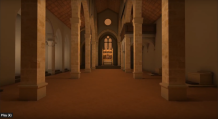Articles

Hidden Florence 3D: San Pier Maggiore uses AR and GPS to place users inside a reconstructed virtual model of the Church at San Pier Maggiore in Florence, which was destroyed in the 18th century.
Technology reunites lost buildings and art of Renaissance Florence for the first time in centuries
The extraordinary lost buildings and art of Renaissance Florence can be viewed together for the first time in centuries thanks to innovative free technology which helps transform the way people experience museums.
People can see how one of the National Gallery’s treasures would have looked in the medieval buildings they were originally designed for. The work contributes to a revolution in how people experience the history and art of the world’s most beautiful cities and galleries.
A free app, Hidden Florence 3D: San Pier Maggiore uses AR and GPS to place users inside a reconstructed virtual model of the Church at San Pier Maggiore in Florence, which was destroyed in the 18th century. By holding the app up to the celebrated multi panelled altarpiece by Jacopo di Cione in the National Gallery, they can see how it would have looked in situ in the church. At the same time, users in Florence will be able to see the church on the very site where it originally stood, reunited with its altarpiece in an innovative use of locative AR that reconnects London and Florence.
Professor Fabrizio Nevola from the University of Exeter, who led the project to develop the app, said: “It will really feel like you are there, witnessing these incredible pieces of art displayed in the way they were originally intended. This work will help us deliver a step change in how art and architectural history is presented.”
The app develops work begun with Hidden Florence, which allows people to navigate the city with a stunningly detailed map from 1584 – geolocated so they can toggle between it and a modern map of Florence – and walk in the footsteps of five contemporary guides, hunting for statutes, street tabernacles, palaces and piazzas.
The walks are led by guides including Cosimo de’ Medici, the “godfather” of the early Renaissance, Giovanni, a wool worker from around 1490 and Marietta as she traces her journey in 1561 from the city orphanage to life as a silk weaver. The characters are voiced by professional actors, including James Faulkner (Game of Thrones, Da Vinci’s Demons) as Cosimo de’ Medici.
Hidden Florence began as a prototype in 2014, with only the Giovanni character and maps. The updated version is produced by developers Calvium and has been written by an international team of historians of Renaissance Italy, and is a collaboration between the universities of Exeter, Cambridge and Toronto.
Professor Nevola said: “Seeing Hidden Florence grow through a series of important collaborations with university colleagues, major galleries and other stakeholders is really exciting. We’ve brought a number of new stories about this city’s complex history to every visitor’s fingertips, using up to date technologies to present cutting edge research about gender, class and power in an accessible way.
“Being able to witness this 14th century artwork in a virtual reconstruction of its original home allows visitors to the National Gallery to put it in its proper historical context and gives the artwork a new lease of life.”
Hidden Florence 3D: San Pier Maggiore’s project partners are Comune di Firenze Patrimonio Mondiale (UNESCO) and MUS.E. The research is funded by the Getty Foundation with the Arts and Humanities Research Council (UK), through the University of Exeter.
Hidden Florence 3D: San Pier Maggiore is on the AppStore and GooglePlay.
Date: 24 August 2020
